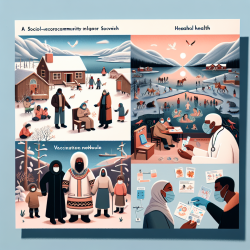Understanding Vaccination in Nunavik: A Practitioner’s Guide
As practitioners dedicated to improving health outcomes for children, it's crucial to understand the complex factors influencing vaccination decisions in Indigenous communities. The study titled “The needle is already ready to go”: communities’ and health care professionals’ perceptions of routine vaccination in Nunavik, Canada provides valuable insights into these dynamics. By leveraging these findings, practitioners can enhance their approach to vaccination in culturally sensitive and effective ways.
Key Findings from the Research
The research utilized the socio-ecological model to identify factors influencing vaccination decisions at various levels:
- Community and Public Policy: Rumors and misinformation about vaccines, language barriers, and cultural differences were significant barriers.
- Organizational: High staff turnover, lack of specialized vaccination workers, and logistical challenges were noted.
- Intrapersonal and Interpersonal: Past experiences, social norms, and attitudes towards vaccines influenced decisions.
Strategies for Practitioners
To improve vaccination outcomes, practitioners can consider the following strategies:
- Cultural Sensitivity: Tailor vaccination services to be culturally appropriate. Engage with community leaders and elders to build trust and understanding.
- Community Involvement: Involve community members in health initiatives. Training local health workers can bridge the gap between Western medical practices and Indigenous health beliefs.
- Information Dissemination: Use diverse communication channels, such as community radio and social media, to counter misinformation and provide clear, accessible information about vaccines.
- Training and Support: Provide additional training for health professionals and interpreters to improve communication and understanding of vaccination processes.
Encouraging Further Research
While this study provides a foundational understanding, further research is needed to explore the nuances of vaccination decision-making in Indigenous communities. Practitioners are encouraged to collaborate with researchers to continue this important work.
Conclusion
By integrating the findings from this study into practice, health care professionals can play a pivotal role in improving vaccination rates and health outcomes in Nunavik. Culturally sensitive approaches and community involvement are key to overcoming barriers and building trust in health care services.
To read the original research paper, please follow this link: “The needle is already ready to go”: communities’ and health care professionals’ perceptions of routine vaccination in Nunavik, Canada.










